Ledger Narratives : The Plains Indian
Drawings of the Lansburgh Collection at Dartmouth College
by Colin G. Calloway
English | 2012 | ISBN: 0806142987 | 292 Pages | PDF | 48 MB
Drawings of the Lansburgh Collection at Dartmouth College
by Colin G. Calloway
English | 2012 | ISBN: 0806142987 | 292 Pages | PDF | 48 MB
The largest known collection of ledger art ever acquired by one individual is Mark Lansburgh's diverse assemblage of more than 140 drawings, now held by the Hood Museum of Art at Dartmouth College and catalogued in this important book. The Cheyennes, Crows, Kiowas, Lakotas, and other Plains peoples created the genre known as ledger art in the mid-nineteenth century. Before that time, these Indians had chronicled the heroic achievements of their warriors and chiefs on rock, buffalo robes, and tipi covers. As they came into increasing contact with American traders, the artists recorded their experiences in pencil and crayon drawings on paper bound in ledger or account books. The drawings became known as ledger art.
This volume presents in full color the Lansburgh collection in its entirety. The drawings are narratives depicting Plains lifeways through Plains eyes. They include landscapes and scenes of battle, hunting, courting, ceremony, incarceration, and travel by foot, horse, train, and boat. Ledger art also served to prompt memories of horse raids and heroic exploits in battle.
In addition to showcasing the Lansburgh collection, Ledger Narratives augments the growing literature on this art form by providing seven new essays that suggest some of the many stories the drawings contain and that look at them from innovative perspectives. The authors—scholars of art history, anthropology, history, and Native American studies—touch on such themes as gender, social status, sovereignty, tribal and intertribal politics, economic exchange, and confinement and space in a changing world.
The Lansburgh collection includes some of the most arresting examples of Plains Indian art, and the essays in this volume help us see and hear the multiple narratives these drawings relate.



